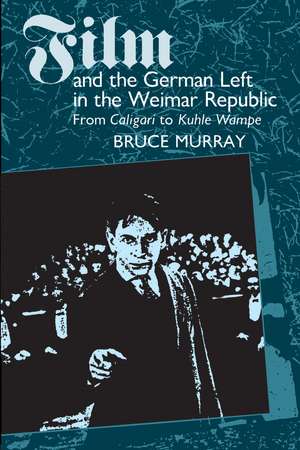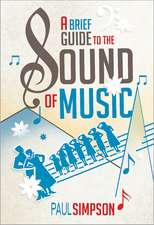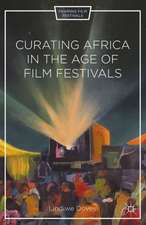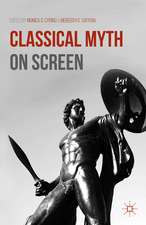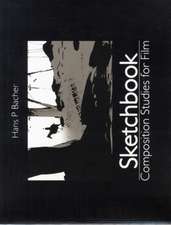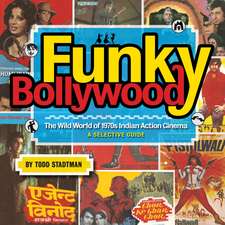Film and the German Left in the Weimar Republic: From Caligari to Kuhle Wampe
Autor Bruce Murrayen Limba Engleză Paperback – iun 1990
Beginning with a brief review of pre-Weimar cinema (1896-1918), he analyzes the film activity of the Social Democratic Party, the German Communists, and independent leftists in the Weimar era. Leftist filmmakers, journalists, and commentators, who in many cases contributed significantly to marginal leftist as well as mainstream cinema, have, until now, received little scholarly attention. Drawing on exhaustive archival research and personal interviews, Murray shows how the plurality of aesthetic models represented in the work of individuals who participated in leftist experiments with cinema in the 1920S collapsed as Germany underwent the transition from parliamentary democracy to fascist dictatorship. He suggests that leftists shared responsibility for that collapse and asserts the value of such insights for those who contemplate alternatives to institutional forms of cinematic discourse today.
Preț: 240.63 lei
Nou
Puncte Express: 361
Preț estimativ în valută:
46.05€ • 50.00$ • 38.68£
46.05€ • 50.00$ • 38.68£
Carte tipărită la comandă
Livrare economică 22 aprilie-06 mai
Preluare comenzi: 021 569.72.76
Specificații
ISBN-13: 9780292724655
ISBN-10: 0292724659
Pagini: 303
Ilustrații: 25 b&w photos
Dimensiuni: 152 x 229 x 15 mm
Greutate: 0.5 kg
Ediția:New.
Editura: University of Texas Press
Colecția University of Texas Press
ISBN-10: 0292724659
Pagini: 303
Ilustrații: 25 b&w photos
Dimensiuni: 152 x 229 x 15 mm
Greutate: 0.5 kg
Ediția:New.
Editura: University of Texas Press
Colecția University of Texas Press
Notă biografică
Bruce Murray is a professor of German studies and global studies at the University of Illinois Urbana-Champaign.
Cuprins
- Acronyms and Abbreviations
- Acknowledgments
- Introduction
- Part One. The Birth of German Cinema and Its Development during the Postwar Crisis: 1919–1923
- 1. 1896–1918: From Country Roads to Main Street and the Discovery of Film by Political Interest Groups
- 2. 1919–1923: The “Golden Years”
- 3. The SPD and Film: From Calls for Reform to Affirmation of Cinematic Entertainment and Edification
- 4. Film and the Communist Left: Leftist Radicalism versus Democratic Centralism and the Consequences for a Communist Film Program
- Part Two. The Years of Relative Stability: 1924–1928
- 5. Hollywood, Moscow, and the Crisis of German Film
- 6. The Developing Relationship between Politics, Economics, and Commercial Film Aesthetics
- 7. The Past as Metaphor for the Present and Der alte Fritz (Old Fritz) as an Example
- 8. The Question of Social Mobility and a Close Look at Die Verrufenen (The Notorious)
- 9. The SPD and Film: Ambivalence toward Mainstream Cinema and the Initiation of an Independent Film Program
- 10. The KPD and Film: The Defeat of Leftist Radicalism, the Theory of the “Scheming” Capitalist Film Industry, and the Communist Response from Panzerkreuzer Potemkin (Battleship Potemkin) to Prometheus
- 11. The Birth of the Volksfilmverband: Partisan Nonpartisanship and Grass-Roots Organization from Above?
- Part Three. The End of the Weimar Republic: 1929–1933
- 12. The Great Coalition and the Disintegration of Parliamentary Democracy
- 13. Sound, the Economic Crisis, and Commercial Film’s Images of the Past, Present, and Future
- 14. The SPD and Film: The Intensifying Critique of Political Reaction in Commercial Film and the Party’s Program of Cinematic Propaganda
- 15. The KPD and Film: From Stubborn Perseverance to Eleventh-Hour Experiments with Alternative Forms of Production and Reception
- 16. The Inevitable Decline of the VFV
- Conclusion
- Notes
- Bibliography
- Index
Descriere
An alternative critical approach to the traditional one of close readings of the classical films.
